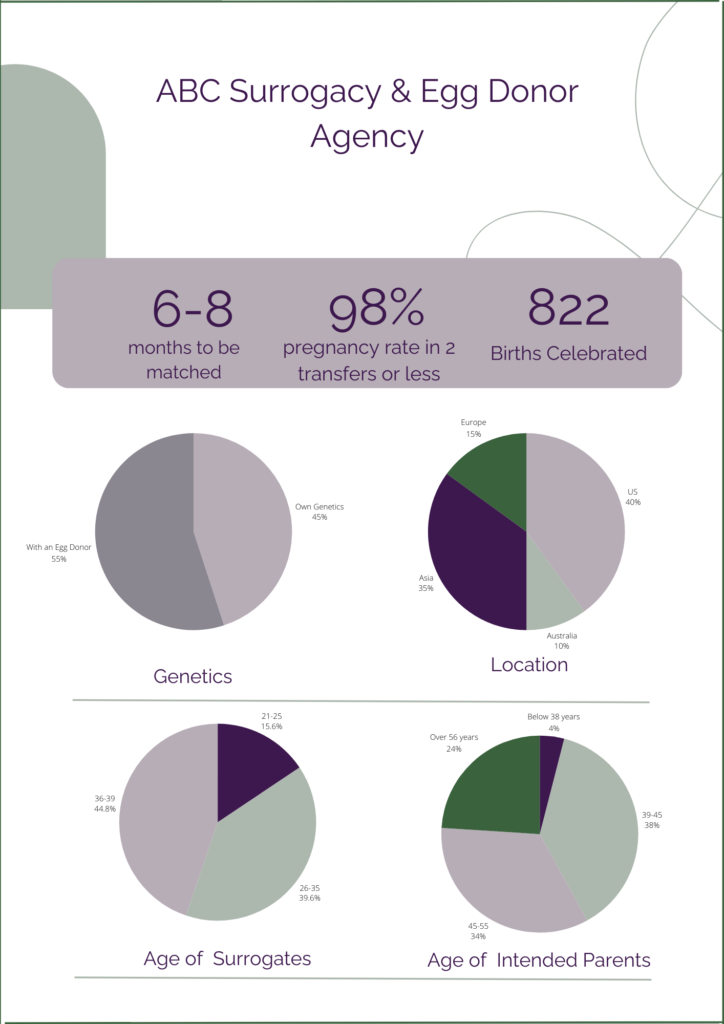Introduction:
In today’s dynamic landscape, surrogacy and egg donor agencies need to be looking at the role of data analytics when planning future growth and the delivery of exceptional service. Statistical insights generated by a CRM can play a pivotal role in empowering agencies to streamline operations, enhance transparency, and assist management in making business decisions. Below are some of the statistical metrics that can be extracted from Customer Relationship Management (CRM) systems:
The Role of Data Analytics:
- Top 5 countries of origin for intended parents.
- Top 10 states with the highest concentrations of intended parents or surrogates.
- Frequency of repeat surrogates in each state.
- Percentage of cases involving an egg donor.
- Success rates for pregnancies resulting from the 1st or 2nd transfer.
- Number of matched surrogates with relevant insurance coverage.
- Distribution of cases by international versus domestic arrangements.
- Breakdown of cases by sexual orientation.
- Success rates for live births after the first embryo transfer compared to multiple attempts.
- Age of eggs leading to successful live births.
- Percentage of surrogate inquiries progressing to matching.
Informed Decision-Making:
With statistical data from CRM systems, agencies can offer verified data to intended parents. These metrics can also provide comprehensive insights into the agency’s performance history. This can instil confidence in prospective parents regarding their choice of agency.
Here is a sample of a data sheet that can be shared with Intended Parents:

Client Experience:
Let’s consider hypothetical scenarios to illustrate the impact of statistical insights on pricing strategies and decision-making:
Charging Transfer Fees:
Suppose an agency aims to increase revenue by implementing transfer fees. The Agency’s statistical analysis reveals that 76% of pregnancies result after the 1st transfer. To address potential concerns from intended parents, the agency introduces a $500 fee for subsequent transfers, applied only after two failed attempts. This additional charge may then be more palatable to the intended parent and the agency is taking a very small risk of lost income if a 2nd transfer is needed.
Regional Demand Disparities:
Another scenario is when an agency wants to charge more for surrogates who are residents of CA. Statistical analysis could be used to unveil regional demand, such as the disproportionately high demand for surrogates in California compared to other states. Analyzing statistics unveils regional demand disparities in that 42.5% of all agencies in the USA are located in California. The next largest demand for surrogates is from Texas with a market share of only 5.7%. This clearly shows that the demand for CA surrogates is disproportionately high and therefore marketing in CA will be costlier than in other states. Agencies may adjust pricing strategies based on market saturation and demand, potentially justifying a surcharge for California surrogates.
Surrogacy-Friendly Insurance Policies:
Statistical insights may justify charging an additional service fee for surrogates with their own surrogacy-friendly insurance policies. If 53% of applicants have their own insurance policy, the Intended parents may be okay with risking having to pay a surcharge for a match with a surrogate who has her own insurance.
By leveraging statistical data, agencies can develop pricing packages that are strategic, competitive, and reflective of the value they provide throughout the surrogacy process.
There are other scenarios where statistics could help an agency in guiding its intended parents. For example: an intended parent only wants to be matched with a CA surrogate. The agency could show them a pie chart showing that 45% of their surrogates are typically located in CA. Therefore, choosing to only be matched with a CA surrogate means they are automatically excluding 55% of eligible candidates. This may at least open the conversation to discuss other candidates and the laws of surrogacy in those other states. The agency could also show the statistics for how long an intended parent waits to be matched with a candidate from CA vs the wait time for another state.
Example of internal data sheet for Management:

The Role of Data Analytics:
Statistical insights empower surrogacy agencies to make informed decisions in pricing strategies, ensuring a balance between affordability to intended parents and the profitability of the agency. Having a CRM will ensure that these kinds of statistics and reports are available on demand to management. Data from a CRM will ensure an agency stays ahead in this evolving industry. In addition, the CRM tools will assist in freeing up the staff so they can offer unparalleled support and transparent communications with parents and surrogates alike.












